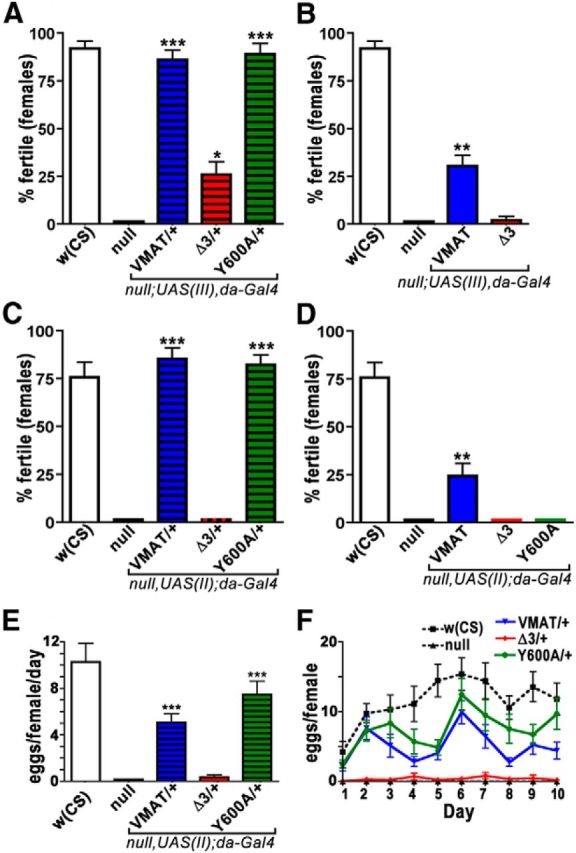Figure 8.

Female fertility and egg laying is compromised by DVMAT-Δ3. A–D, Potential rescue of the dVMATP1 mutant defect in female fertility was tested using one copy of the indicated DVMAT transgene and one copy of the da-Gal4 driver (A, C) or two copies of both the indicated DVMAT transgene and da-Gal4 driver (B, D). Insertion sites for the UAS transgenes were on either chromosome 3 (A, B) or chromosome 2 (C, D). One copy of either DVMAT-wt or DVMAT-Y600A on the third (A) or second chromosomes (C) rescued female fertility to control w(CS) levels; the DVMAT-Δ3 insertions on the second and third chromosomes did not rescue female fertility. B, D, Fertility defects were observed for flies expressing two copies of DVMAT-wt, DVMAT-Y600A, or DVMAT-Δ3 with two copies of the da-Gal4 driver. Columns in A–D indicate the average percentage of crosses yielding any progeny, mean ± SEM, n = 41–69 vials per genotype; one-way ANOVA, p < 0.0001 for all panels; Bonferroni post-test, *p < 0.05, **p < 0.01, or ***p < 0.001, as indicated between null and rescue lines. E, F, Egg laying. Shown are the average number of eggs laid (mean ± SEM) per female (fecundity) for dVMATP1 nulls rescued with one copy of UAS-DVMAT-wt, UAS-DVMAT-Y600A, and UAS-DVMAT-Δ3, and one copy of da-Gal4. Each set of mating sessions was scored for 10 d and is displayed as either the overall average across all 10 d (E) or the number of eggs for each day of the testing period (F). The number of eggs laid for w(CS) controls is also shown. dVMATP1 null females (null) are essentially unable to lay eggs. This defect is partially rescued using one copy of UAS-DVMAT-wt or UAS-DVMAT-Y600A, but not UAS-DVMAT-Δ3. One-way ANOVA, p < 0.0001; Bonferroni post-test, ***p < 0.001 as indicated compared with dVMATP1 null; n = 18–26 vials per genotype.
